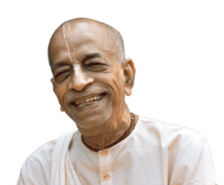

Important points and unresolved questions on 21000+ changesin Srimad Bhagavatam (first four cantos)
Some important points:
- From that list of 21000+ changes(shown later in this section), it is evident that it is not that only the first 2 chapters of the first canto were changed,but the first 4 cantos were changed and the same is replicated in the 10 volume set.
- It also looks like many have not even gone through these changes completely and have started to criticize just by reading the first few paragraphs from them. (WE REQUEST ALL THE DEVOTEES TO SPEND SOME OF THEIR VALUABLE TIME AND GO THROUGH EACH AND EVERY CHANGE THAT WILL BE HIGHLIGHTED BELOW.)
- The changes list contains a compilation of differences in tabular form.
- The compilation shows how they have deleted so many pages from 2nd and 4th cantos without authorization. For example, take 4.28.20 purport.
- The left part shows the 30 volume set content(first edition). Compare it with 10 volume set(right part). We see that so many lines consisting of almost a page have been cut off. These changes have been documented already.
- These deletions are unfortunately found in the so-called 10 volume original set.
- To verify with it, open either https://prabhupadabooks.com/sb/4/28/20 or the respective verse from the 10 volume set and verify with the tabular comparison done. After analyzing it, so many deletions shall be noticed. There are a lot more to show which will be covered later in the article.
We request all the devotees to firstly realize the seriousness of such unethical removal of very important verses, paragraphs,lines from the Srimad Bhagavatam, mainly the 4th canto volumes. Will Srila Prabhupada be satisfied to see his books being considered a plaything where anyone can do any type of nonsense editing to satisfy his whims?
To those who are still distributing the 10 volume set, please ask yourself these questions and ruminate whether Srila Prabhupada will be satisfied after such distribution.
Some questions that must be discussed:
1. If only the first 2 chapters of the first canto were revised during 1976, why are thousands of changes in all the first 4 cantos found? Why are the same changes in these 4 cantos present in the 10 volume set as shown above?
2. Even if we accept the claim made by the editors who say they got approval from Srila Prabhupada for revising only for the first 2 chapters of the first canto, where is the approval for 21000+ changes to be made in all four cantos?
In the 7th September 1976 letter, we only see Srila Prabhupada approving corrections only for the first 2 chapters (“Concerning the editing of Jayadvaita Prabhu, whatever he does is approved by me. I have confidence in him.Your changes which I have seen of the sanskrit synonyms is also approved by me”.).If they got an approval, it is only for the first 2 chapters of the first canto and not for all 4 cantos as per that letter. Also the letter dated August 31,1976 by Radhavallabha Prabhu asks for approval only for the first 2 chapters.There is no such letter which shows Srila Prabhupada’s approval for changing these 4 cantos.Where is the approval for cutting off so many lines,verses and paragraphs in 2nd and 4th cantos?
Where is the recorded room conversation with Srila Prabhupada and Jayadvaita Swami [as he has claimed] allegedly authorizing all these changes?
3. Why does the 10 volume set have the same changes in all 4 cantos if they claim it as “original”?
4. Who exactly made so many revisions in these 4 cantos?
5. Why does the BBT Edit Review website show the changes made only in the first 2 chapters of the first canto and not all the changes in 4 cantos?
6. Did Srila Prabhupada ever want to remove front covers and merge them into 10 volumes? He did make such a statement in 1968 but that was the time when there was only 1st canto available. After this, we only find Srila Prabhupada’s desire to complete the entire Srimad Bhagavatam in 60 volumes and he used to say the same till 1977. There are so many instructions with respect to this found in the vedabase. But he could only dictate till the first few chapters of the 10th Canto. Therefore, what we have as an original set is the 30 volume Bhagavatam.
7. If the 10 volume set is really original, then why are its supporters unwilling to look at so many deletions in these books(esp 2nd and 4th cantos)?
8. Is the 10 volume set really “pre-1978”? If it is so, then why is it that the changes that were made in the first 4 cantos during 1978 replicated in this set?
At first, it was thought by all that only some parts of the first two cantos are second editions printed prior to 1978. But after checking the publication years for every volume, it was noticed that some volumes are printed after 1977. The proof for this is shown below. The second edition printing years after 1977 are set to bold.
There is another question that comes about the first canto of this 10 volume set being the 1976 edition. We know that the mistake in the verse 1.2.5 was emphasized by Srila Prabhupada in June 1977. They have just partially corrected this verse keep the meaning of Sadhu as “this is relevant” despite Srila Prabhupada mentioning the meaning of Sadhu meaning noble,pious,etc in the lectures given on this verse.
From the table below, the 3rd edition which supposedly contains that partial correction of 1.2.5 is said to be printed in 1978. How is it that the mistake that was brought up in 1977 corrected in 1976? Now some people may say that it was already corrected in 1976. To refute that, there is another proof to this. This so called BBTedit.com website in this link http://bbtedit.com/Bhagavatam_revisions_examined explains the revisions made by the editors in 1976 which excludes 1.2.5. They have also deceived the devotees by presenting the approval for revisions done in 1976 only for first 2 cantos as an approval for making 21000+ changes in first 4 cantos. Rest of the changes in the remaining 6 cantos will be dealt separately. The total number of changes in the entire Srimad Bhagavatam is something that will make anyone astonished.
We ask those who are promoting this so called original set that why haven’t they cross-checked these revisions in so many cantos before publishing these sets? Why do the 10 volumes in the new set have the same 21000+ changes?
| BBT Books | Edition | Year | |
| 1 | SRIMAD BHAGAVATAM 1:1 | 1st | 1972 |
| 2 | 1:01 | 6th | 1976 |
| 3 | 1:01 | 8th | 1978 |
| 4 | 1:02 | 1st | 1972 |
| 5 | 1:02 | 4th | 1976 |
| 6 | 1:03 | 1st | 1972 |
| 7 | 1:03 | 3rd | 1976 |
| 8 | 1:03 | 3rd | 1976 |
| 9 | 1:03 | 4th | 1978 |
| 10 | 2:01 | 1st | 1972 |
| 11 | 2:01 | 7th | 1977 |
| 12 | 2:01 | 7th | 1977 |
| 13 | 2:01 | 8th | 1978 |
| 14 | 2:02 | 1st | 1972 |
| 15 | 2:02 | 3rd | 1976 |
| 16 | 3:01 | 1st | 1972 |
| 17 | 3:01 | 3rd | 1977 |
| 18 | 3:02 | 1st | 1974 |
| 19 | 3:02 | 2nd | 1977 |
| 20 | 3:02 | 2nd | 1977 |
| 21 | 3:03 | 1st | 1974 |
| 22 | 3:03 | 2nd | 1978 |
| 23 | 3:04 | 1st | 1974 |
| 24 | 3:04 | 2nd | 1978 |
| 25 | 4:01 | 1st | 1972 |
| 26 | 4:01 | 2nd | 1977 |
| 27 | 4:02 | 1st | 1974 |
| 28 | 4:02 | 2nd | 1978 |
| 29 | 4:03 | 2nd | 1978 |
| 30 | 4:03 | 1st | 1974 |
| 31 | 4:03 | 2nd | 1978 |
| 32 | 4:04 | 1st | 1974 |
| 33 | 4:04 | 2nd | 1978 |
Source: http://harekrsna.com/sun/editorials/01-09/inventory.xls
9. Why is “the original way” taken as a second edition by some devotees who make their own conclusions? Before he mentioned the “original way”, changes in both “Isopanisad and Srimad Bhagavatam” were discussed.
Here Srila Prabhupada boldly says “I know that these rascals are doing. What can be done? How they can be relied on? “, which expresses his denial of the 1974 revised Isopanisad edition.
Why are these 10 volume distributors making their own conclusions wrt the original printing?From this anyone can easily conclude that the first printing itself is the original way.
There is no such statement where Srila Prabhupada approves changes 4 cantos in the Srimad Bhagavatam.
Regarding Sri Isopanisad changes: (Srila Prabhupada disapproves the changes)
Yaśodā-nandana: In the Gurukula we were teaching Īśopaniṣad class to the children. So we took… [break] …Prabhupāda and the words which the recent edition of the Press is wrong. Many changes were brought. They were trying to make better English, but sometimes, to make better English, I think they were making philosophical mistakes also. There is no so much need of making so much better English. Your English is sufficient. It is very clear, very simple. We have caught over 125 changes. They’re changing so many things. We are wondering if this is necessary. I will show you today. I have kept the book.
Srila Prabhupāda: I know that these rascals are doing. What can be done? How they can be relied on?
[……..]
Yaśodā-nandana: Sometimes they appeal that “We can make better English,” so they change like that, just like in the case of Īśopaniṣad. There are over a hundred changes. So where is the need? Your words are sufficient. The potency is there. When they change, it is something else.
Svarūpa Dāmodara: That’s actually a very dangerous mentality.
Yaśodā-nandana: What is it going to be in five years? It’s going to be a different book.
Prabhupāda: So you… What you are going… It is very serious situation. You write one letter that “Why you have made so many changes?” And whom to write? Who will care? All rascals are there. Write to Satsvarūpa that “This is the position. They are doing anything and everything at their whim.” The next printing should be again to the original way.
[Rascal editors conversation, June 22,1977, Vrindavan]
Misleading/insufficient evidences presented for approval of changes in Srimad Bhagavatam (1976+ editions)
But if we publish our Srimad Bhagavatam exactly in the way I have already begun it, it will be a unique contribution. The scholars only require diacritic marks. Then it is all right. That should be very correct and standard. If there is devanagari character it is still better.
[July 24,1969 – Letter to Pradyumna written from Los Angeles]
Hare Krsna. All glories to His Divine Grace A.C. Bhaktivedanta Swami Prabhupada. This article is presented to expose the misleading evidence presented by those who endorse the 10 Volume Red Srimad Bhagavatam.
The evidence given by them is the letter by Radhavallabha Prabhu to Srila Prabhupada on August 31, 1976. This letter asks for corrections of only “first 2 chapters of the Canto 1”. Srila Prabhupada approved the changes only for these 2 chapters on 7th September 1976 and NOT FOR CHANGING ALL 4 CANTOS.
But again, according to the rascal editors conversation, Srila Prabhupada makes a statement to go back to the original way. Therefore, we must STICK TO THE FIRST EDITIONS WITHOUT ANY HESITATION.
What has been found in the Red set is that it does not only contain changes to the first canto, but all 4 cantos. (Proof shown in the later part of the article.)
WE ASK THOSE WHO ARE DISTRIBUTING THE SO CALLED ORIGINAL BHAGAVATAM TO PRODUCE A BONAFIDE PROOF WHERE SRILA PRABHUPADA APPROVES CHANGES FOR ALL 4 CANTOS. There are 21000+ changes found. Please produce a proof of approval for these changes signed by Srila Prabhupada himself.
Let us first see what proof these people present:


Srila Prabhupada’s response:Letter to: Radhavallabha
—
Vrindaban
7 September, 197676-09-07
Los AngelesMy Dear Radhavallabha das,Please accept my blessings. I am in due receipt of your letters dated August 25 and 31 and have noted the contents.Concerning the editing of Jayadvaita Prabhu, whatever he does is approved by me. I have confidence in him. Your changes which I have seen of the sanskrit synonyms is also approved by me. Tanmayataya refers to the fact that the trees and the father were absorbed in the same feelings.Titling of the Ninth Canto as Liberation is good, and the Tenth Canto should be called “The Summum Bonum”. As far as the 11th and 12th Cantos are concerned they shall be named when they are presented. The title which you have given to the Eighth Canto was a little hard to understand at first but if it refers to pralaya, then it is alright. You must consult with me on such matters. Do not manufacture anything.All of the sketches which you have sent to me while I am in India are approved. The picture of the MohiniMurti capturing the demons should take place outside on grass, there is no floor or walls. PrahladaMaharaja does not have a beard. Always avoid beards. It is not true that there are no shoes in Krsnalila, rather there are shoes except for the Vrndavana pastimes. But the shoes are of another quality, they are beautiful with jewels etc. On the battlefield they must wear shoes. The severed head of Rahu should look like the head of a demon, not round like a planet.By controlling sex desire one becomes the most perfect sober person, kandutivan manasajivam visaheta dhirah. I hope this meets you in good health.Your ever well-wisher,
A.C. Bhaktivedanta SwamiACBS/hsAfter noticing such insufficient proofs, we get some questions like these:
1. Where is the proof of an approval for changes in all 4 cantos? 2. Where is a detailed list of all these 21000+ changes submitted to Srila Prabhupada for an approval?3. Did Srila Prabhupada see all these massive changes personally and approved in writing?
These people have no answer to any of the questions above and are involved in misleading those who sincerely want to read original books.
List of changes:
Detecting Srila Prabhupada’s Original Books:https://harekrsna.org/detecting-srila-prabhupadas-original-books/
This 10 Volume set cannot be called the original set as it has the same changes that are found in the links below(it is not the 1972 print). Also Srila Prabhupada had never instructed to take out the front covers of the books and merge them as 10 cantos.
Google drive with Srila Prabhupada’s first edition unrevised, non adulterated, original books.
https://drive.google.com/drive/folders/1nHm72gVwAeei95WDkSLf2aw5x-jRXDoF?usp=sharing
Another folder for Srimad Bhagavatam 1972 on-wards first edition original books:
https://drive.google.com/drive/folders/1am9rKGII3wMrmkyxHp85hfjMjgnWGzT9?export?format=pdfIDENTIFY THE ORIGINAL SET:

The scripts on the left show original first editions and the right hand side shows the editions from 1976. Note: The estimation of the number of changes has been done carefully after eliminating the count of other trivial changes(missing sanskrit script on left side or some part of previous script appearing in the new parts) that might be shown by the software.
Note: To download/print the files containing changes: Click on the above link. Then click File -> Export/Print -> Side-by-Side view respectively.
Canto 1: (Over 6000 changes) Chapters 1-4: https://draftable.com/compare/UTXTvIzsNrmuChapters 5-8: https://draftable.com/compare/cupjyEEYuyGnChapters 9-12: https://draftable.com/compare/yllqQqNZSlgP
Chapters 13-16: https://draftable.com/compare/VCGEgShIgbNU
Chapters 17-19: https://draftable.com/compare/pMtvfQINaQtE
Canto 2: (Over 6000 changes)Chapters 1-4: https://draftable.com/compare/wwucNCVgfccFChapters 5-8: https://draftable.com/compare/iimgbZjLWGTkChapters 9-10: https://draftable.com/compare/VaeVzKEAplpN
Canto 3: (Over 4000 changes)Chapters 1-5: https://draftable.com/compare/WBtcORNEGUtAChapters 6-11: https://draftable.com/compare/EZtdJyOoixCDChapters 12-16: https://draftable.com/compare/WMdbAnBHPWcF
Chapters 17-22: https://draftable.com/compare/PWktcoYEdibW
Chapters 23-26: https://draftable.com/compare/zTHMikJhqgiFChapters 27-31: https://draftable.com/compare/HIsgZlxBsjPM
Chapters 32-33: https://draftable.com/compare/MFPehjhLQCun
Canto 4: (Over 5000 changes)Chapters 1-6: https://draftable.com/compare/ushTtFMkmfIqChapters 7-10: https://draftable.com/compare/AkqAwNZEppInChapters 11-16: https://draftable.com/compare/MQvlEISQSJVR
Chapters 17-21: https://draftable.com/compare/OjFXdGtBAdNz
Chapters 22-23: https://draftable.com/compare/dEfZIREardwXChapters 24-26: https://draftable.com/compare/NfFVFBiJXaSGChapters 27-29: https://draftable.com/compare/QzYaMiIksWiKChapters 30-31: https://draftable.com/compare/uNPTJpGUBUdi
Few changes are analysed below, especially hundreds of deletions from these books since it is not possible to highlight all 21000+ changes.
For all tables: Left side contains the First print books, Right side has 1976 onwards revised editions.
The following is just a list of a few changes to keep the article brief. The links above have a list of all changes and one can find so many adulterations in these links.
CANTO 2 DELETIONS:
2.3.36 P

2.9.2 P
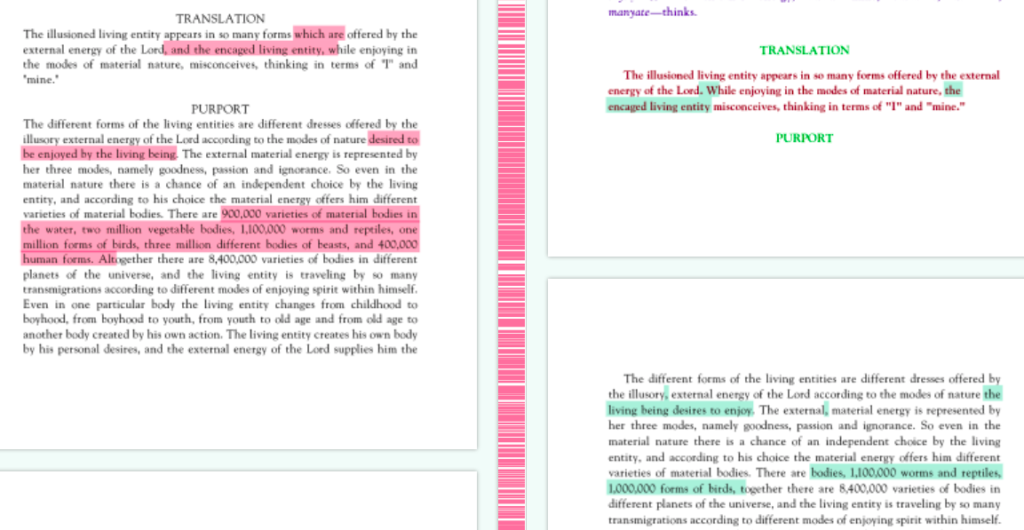
2.9.17 P
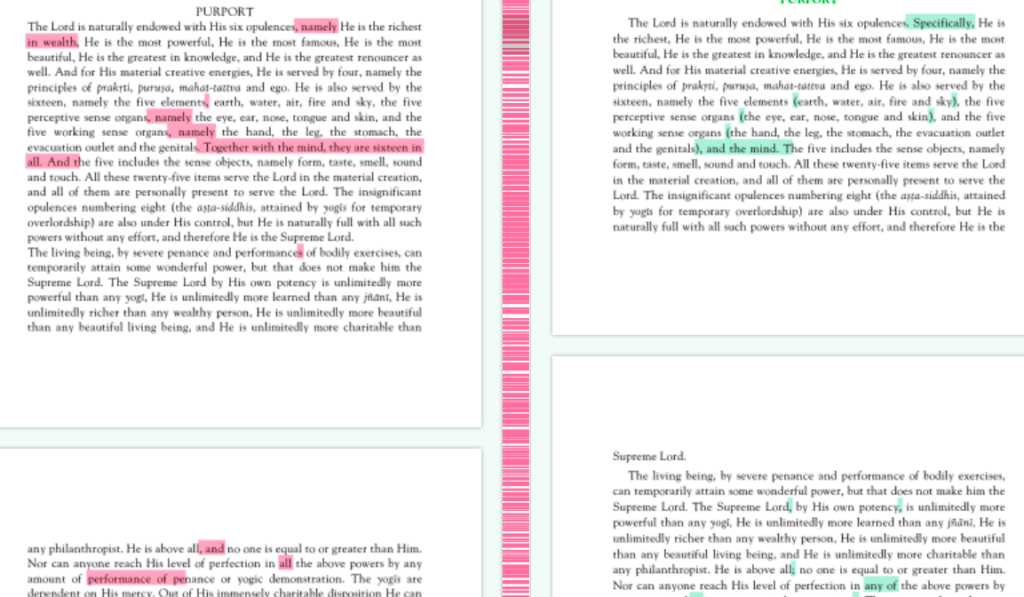
2.9.38 P

CANTO 4 DELETIONS:4.13.11 T

4.27.3 P

4.27.5 P

4.27.9 P (One entire verse removed)
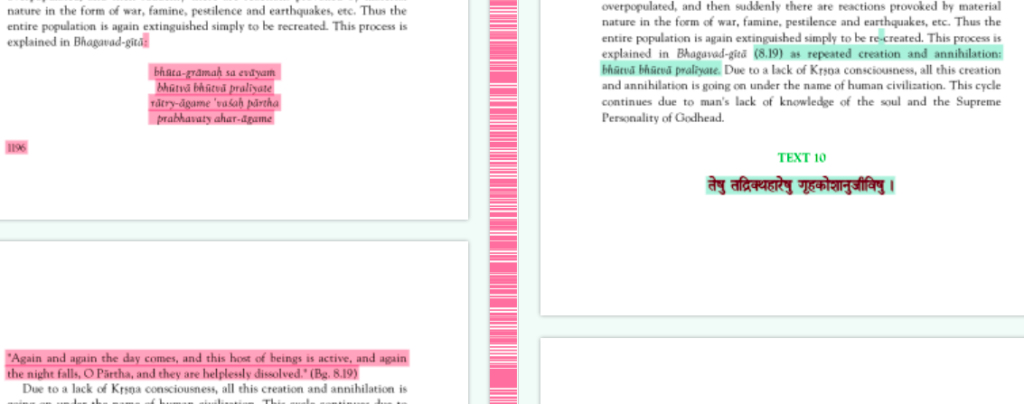
4.27.10 P

4.28.20 P (Content consisting of almost a page cut off)
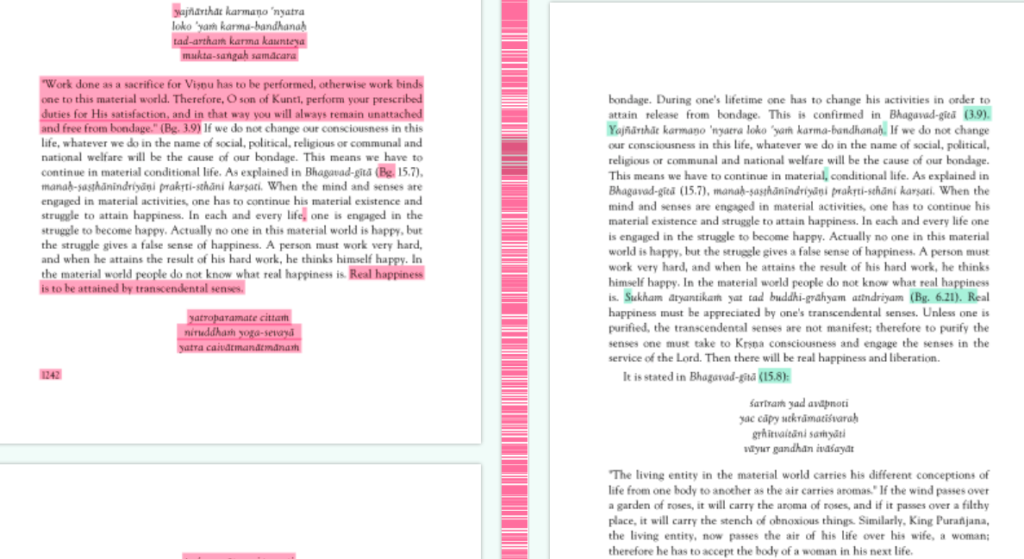
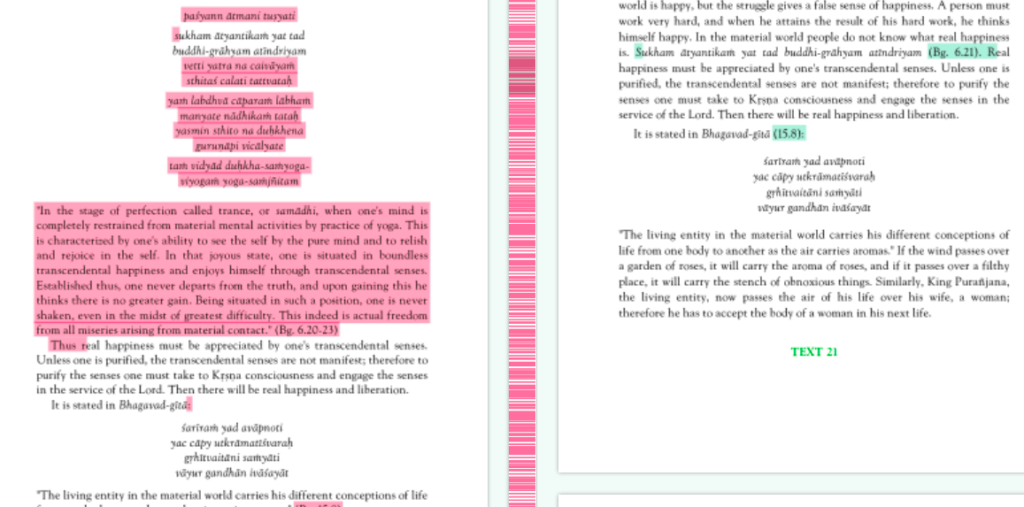
4.28.25 P
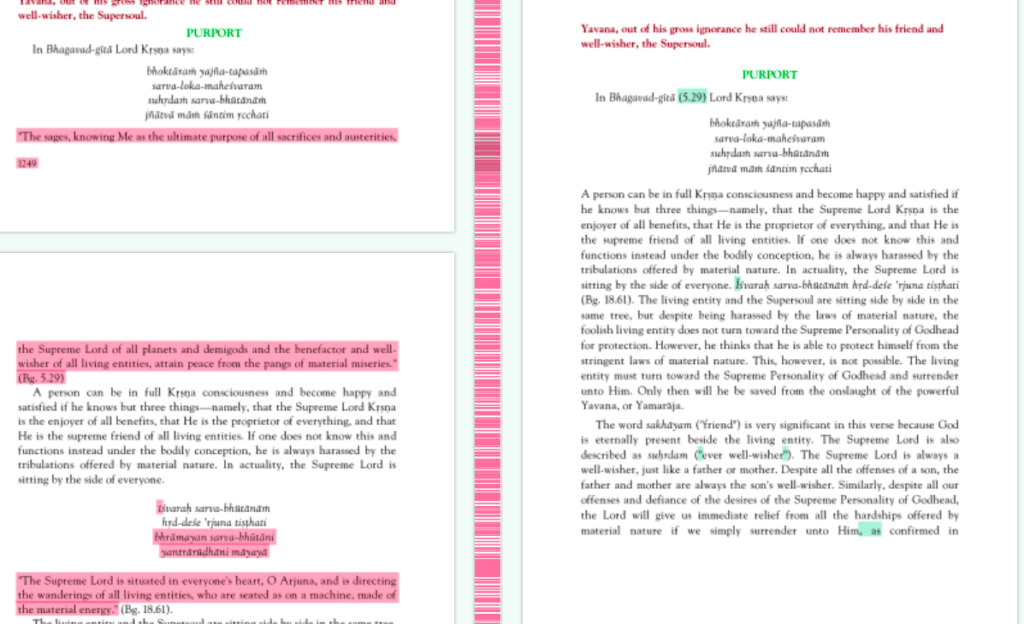
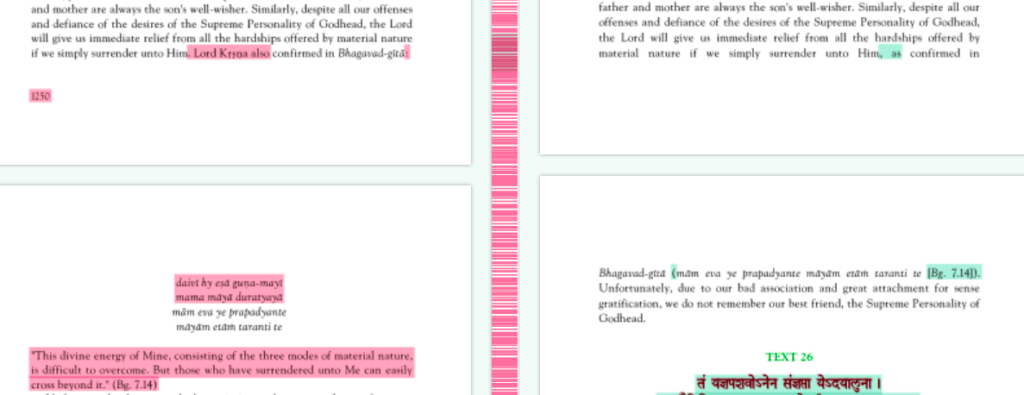
4.29.78 P

4.31.14 P
There are many who say that 1972 First Cantos had discrepancies. BUT WE SEE HERE THAT HAYAGRIVA PRABHU AND SRILA PRABHUPADA WORKED ON THESE AND SRILA PRABHUPADA APPROVED THE WORK.
Chapter 2, Transcendental Invitations. (Hare Krsna Explosion)
The next morning, when I go alone to see the Swami, he seems to be expecting me. Directly and simply, he begins to explain that he needs help in spreading Krishna consciousness around the world. Noticing that he has been typing, I offer to type for him, and he hands me the manuscript of the First Chapter, Second Canto, of Vyasadeva’s Srimad-Bhagavatam.
“You can type this?”
“Oh yes,” I say.
He is delighted. We roll a small typewriter table out of the corner, and I begin work. His manuscript is single spaced without margins on flimsy, yellowing Indian paper. It appears that the Swami tried to squeeze every word possible onto the pages. I have to use a ruler to keep from losing my place.
The first words read: “O the king.” I naturally wonder whether “O” is the king’s name, and “the king” stands in apposition. After concluding that “O King” is intended instead, I consult the Swami.
“Yes,” he says. “Change it, then.”
As I retype another paragraph, I notice certain grammatical discrepancies, perhaps typical of Bengalis who learned English from British headmasters in the early 1900s. Considerable editing is required to get the text to conform with current American usage.
After pointing out a few changes, I tell the Swami that if he so desired, I could make all the proper corrections.
“Very good,” he says, smiling. “Do it! Put it nicely.”
Thus my editorial services begin.
I type all morning in the room where he reads, translates, welcomes visitors, and “takes rest.” There is a tin footlocker, used as a desk, and a rug on which he sits and sometimes sleeps. Apart from my typewriter table, there is no other furniture. As I type, I hear him cooking in the kitchen, and can smell the butter being boiled to make ghee. I finish the chapter: twenty pages, double spaced with wide margins. The original had filled only eight pages.
“Let me know if there’s any more work,” I tell him. “I can take it back to Mott Street and type there.”
“More? Yes,” he says. “There is lots more.”
He opens the closet door and pulls out two large bundles tied with saffron cloth. Within, he shows me thousands of pages of single spaced, marginless manuscripts of literatures unknown in the Western world. I stand before them, astounded.
“It’s a lifetime of typing,” I protest.
“Oh, yes!” he smiles happily. “Many lifetimes.”1.2.5 is NOT FULLY CORRECTED in Srimad Bhagavatam 1976 version
This article is compiled to explain to some about the erroneous changes in the 1976 SB(first 4 cantos) who still support these despite pointing out 21000 changes and many deletions.To explain their position, they consider only this edit of 1.2.5 saying that it is corrected, but it is only partially corrected which shall be proved below.
Other than that, they fail to see so many pages cut off from 2nd and 4th cantos and the same is replicated in the 10 volume set as well as shown on many sites that claim to have original books. One can just open those revised books or websites and see the changes.
Who authorized the editors to cut so many pages or lines from these cantos? No one can answer this.According to BBT edit site, they claim that they have only changed the first 2 chapters of the first canto. They never mention of changing all 4 cantos. What kind of deception is this?In their website, there is a link to “Srimad Bhagavatam Revisions explained”. There they have done some tabular comparisons for first two chapters of the first canto but they do not even show the verse 1.2.5 has been changed.
Let us first analyze this issue about 1.2.5 in both 1972 and 1976 editions. It is only this error in the synonyms that Srila Prabhupada wanted to get corrected and not that the entire 1972 SB should be rejected. If he had really rejected the entire first canto, he would not have continued to make some comments on the verses following 1.2.5. A simple correction was all that he wanted and not 21000 changes.
In the same manner, Srila Prabhupada did see one or two errors in his Macmillan Bhagavad Gita. He just wanted to get them corrected and not replace the entire edition with over 5000 changes as was done in 1983. When did Srila Prabhupada every mention to make 1000s of changes in the name of correcting one or two errors?
If this was really the original way, then why were so many lines, verses and pages cut from 2nd and 4th Cantos? Does Srila Prabhuapada ever say that pulling out anything whimsically and shortening the book is the “original way”? Where is the proof of Srila Prabhupada approving 100s of deletions in 2nd and 4th Cantos? These things were not even shown to him, what to speak of getting approved by him.
Why do many invent their own definition of “original way”? In the same conversation, Srila Prabhupada was unhappy over Isopanisad revisions done in 1974. The order of the next printing to be done the original way was told after both Srimad Bhagavatam and Isopanisad revision issue were brought up. If the revised editions were the original way, then Srila Prabhupada would not have expressed his displeasure stating “I know that these rascals are doing. What can be done? How they can be relied on?” immediatelyafter hearing Isopanisad changes.
Now the original way is obviously the first edition as we can observe here. But we also see that just because of this mistake in the 1972 edition, the entire edition is being rejected by some. But at the same time they overlook the fact that the same mistake is only partially corrected and also more pages have been cut off from the 2nd prints. In these 2nd editions, not only have they repeated the same mistake which Srila Prabhupada asked to rectify, but they have made more and more mistakes in the name of “corrections”.
Comparison: The left side shows the 1972 edition and the right side shows the 1976 edition.
| 1 | TEXT 5 | 1 | TEXT 5 | ||
| 2 | munayaḥ sādhu pṛṣṭo ‘haṁ | 2 | munayaḥ sādhu pṛṣṭo ‘haṁ | ||
| 3 | bhavadbhir loka-maṅgalam | 3 | bhavadbhir loka-maṅgalam | ||
| 4 | yat kṛtaḥ kṛṣṇa-sampraśno | 4 | yat kṛtaḥ kṛṣṇa-sampraśno | ||
| 5 | yenātmā suprasīdati | 5 | yenātmā suprasīdati | ||
| 6 | 6 | SYNONYMS | |||
| 7 | munayaḥ—of the sages; sādhu—this is relevant; pṛṣṭaḥ—questioned; aham—myself; bhavadbhiḥ—by all of you; loka—the world; maṅgalam—welfare; yat—because; kṛtaḥ—made; kṛṣṇa—the Personality of Godhead; sampraśnaḥ—relevant question; yena—by which; ātmā—self; suprasīdati—completely pleased. | 7 | munayaḥ—O sages; sādhu—this is relevant; pṛṣṭaḥ—questioned; aham—myself; bhavadbhiḥ—by all of you; loka—the world; maṅgalam—welfare; yat—because; kṛtaḥ—made; kṛṣṇa—the Personality of Godhead; sampraśnaḥ—relevant question; yena—by which; ātmā—self; suprasīdati—completely pleased. | ||
| 8 | TRANSLATION | 8 | TRANSLATION | ||
| 9 | O sages, I have been justly questioned by you. Your questions are worthy because they relate to Lord Kṛṣṇa and so are of relevance to the world’s welfare. Only questions of this sort are capable of completely satisfying the self. | 9 | O sages, I have been justly questioned by you. Your questions are worthy because they relate to Lord Kṛṣṇa and so are of relevance to the world’s welfare. Only questions of this sort are capable of completely satisfying the self. |
What is the change? “of the sages” is changed to “O sages”. This change is right as it is addressing them(sambodhana vocative). But what about sadhu? Sadhu means they are very pure as mentioned by Srila Prabhupada in the conversation below. In the 1976 print, sadhu is still kept as “this is relevant”.
Why have they not fully corrected it if they claim their revisions are authorized?
Lecture on BG 9.2-5 — New York, November 23, 1966: There are so many yogis who say, “Oh, the sun, moon and everything is floating within me,” imitating. They think that “If Kṛṣṇa, if Kṛṣṇa can say like that, I am that, I am also Kṛṣṇa. I am also God. So I can also say like that.” But Kṛṣṇa can show the universal form. Will you please show me the univer…? “No, that I cannot.” Oh, Kṛṣṇa lifted the hill in seven years old. Can you lift a one mound, or hundred pounds with your finger? “Oh, that I cannot do.” That is the difference between the imitation God and real God. “Because Kṛṣṇa is saying, therefore I shall imitate and say.” And because Kṛṣṇa performed rāsa-līlā… “Oh, Kṛṣṇa married sixteen thousand wives.” “Oh, can you marry one and keep her very nicely in a palace?” “Oh, that I cannot do.” Then how can you be Kṛṣṇa? Kṛṣṇa said so many things, wonderful, and He acted also wonderful. If you believe one thing and do not believe another thing, then it is called ardha-kukkuṭī-nyāya (CC Ādi-līlā 5.176). Ardha-kukkuṭī-nyāya. I cannot believe half. If you believe, you believe full.
Rascal editors conversation, June 22,1977:
Prabhupāda: That… Find this verse, munayaḥ sādhu pṛṣṭo ‘ham… [SB 1.2.5].
Devotee (1): Munayaḥ sādhu pṛṣṭo ‘ham.
Tamāla Kṛṣṇa: [aside:] There’s no index. It’s not a new Bhāgavatam. There’s no index in this Bhāgavatam. Munayaḥ sādhu…? “The Effects of Kali-yuga” chapter? Is that the verse, about the effects of Kali-yuga? No. [background talking, looking for verse]
munayaḥ sādhu pṛṣṭo ‘haṁ
bhavadbhir loka-maṅgalam
yat kṛtaḥ kṛṣṇa-sampraśno
yenātmā suprasīdati
[SB 1.2.5]
“munayaḥ—of the sages; sādhu—this is relevant; pṛṣṭaḥ—questioned; aham…”
Prabhupāda: No? What is that? Sādhu? What is that? Munayaḥ?
Tamāla Kṛṣṇa: Says, “sādhu—this is relevant.”
Prabhupāda: Relevant?
Tamāla Kṛṣṇa: That’s what it’s translated as, “this is relevant.” May be a mistake.
Devotee (1): It’s a mistake.
Prabhupāda: Munayaḥ?
Tamāla Kṛṣṇa: “Munayaḥ—of the sages; sādhu—this is relevant…”
Prabhupāda: The nonsense, they are… They are correcting my trans… Rascal. Who has done this? Munayaḥ is addressing all these munis.
Tamāla Kṛṣṇa: It’s addressing the munis?
Prabhupāda: Yes.
Tamāla Kṛṣṇa: Sādhus, great sages.
Prabhupāda: Yes. Sādhu means they are very pure. What can be done if it goes there and these rascals become Sanskrit scholar and do everything nonsense? One Sanskrit scholar strayed, that rascal… He take… What is his…? Śacī-suta? Śacī-sandana?
Tamāla Kṛṣṇa: Jaya-śacīnandana?
Prabhupāda: And they are maintaining them. Different meaning.
Tamāla Kṛṣṇa: “Bhavadbhiḥ—by all of you; loka—the world; maṅgalam—welfare; yat—because; kṛtaḥ—made; kṛṣṇa—the Personality of Godhead; sampraśnaḥ—relevant question; yena—by which; ātmā— self; suprasīdati—completely pleased.” Translation = “O sages…”
Prabhupāda: Now here is “O sages,” and the word meaning is “of the munis.” Just see.
Tamāla Kṛṣṇa: “Which is relevant.”
Prabhupāda: Such a rascal Sanskrit scholar. Here it is addressed, sambodhana, and they [indistinct] it—“munayaḥ—of the munis.” It is very risky to give to them for editorial direction. Little learning is dangerous. However proper Sanskrit scholar, little learning, dangerous. Immediately they become very big scholars, high salaried, and write all nonsense. Who they are? [pause] Then?
Tamāla Kṛṣṇa: “O sages, I have been…”
Prabhupāda: No, they cannot be reliable. They can do more harm. Just see here the [indistinct].____________________
From the above conversation, it is evident that this is not fully corrected in the 1976 editions.Also, there is not a single tape found where Srila Prabhupada was giving a lecture from the 1976 edition.To defend all this, the BBTI has also done some notorious things. What they have done is that they have inserted the 1976 translation in a lecture on 1.7.7 given in 1975 by cutting the first line that was changed in 1976.This link – https://arsaprayoga.com/2019/01/02/bbt-international-cutting-in-srila-prabhupadas-lectures/ exposes the same. Video – https://www.youtube.com/watch?v=s-NTNNVzP-I
Thus we can understand the propaganda carried out by those who want to defend the book changes.They go to such an extreme point that they even cut out the originals and replace the edited versions just to convince the readers that Srila Prabhupada gave lectures from the 1976 editions at the time when it wasn’t even published.
Other than that, we have all proof about the horrendous editing done in the first 4 cantos which are a part of the pre 1978 changes and the same has been replicated in the 10 volume set and 18 volume set.We shall therefore stick to the original way defined by Srila Prabhupada, which are the first editions.
Quotes against unnecessary book changes:
“That is his tendency, to correct. That’s very bad. He should not do that. The system is: whatever authority has done, even there is mistake, it should be accepted.”Room Conversation — February 27, 1977, Mayapura
The authorized edition of Bhagavad-gita will help to stop the terrible cheating of ‘gurus’ and ‘yogis’ who are false and unauthorized
Letter to Svarupa, Ranadhira — Mayapur 3 February, 1976
Yes, there is no need for corrections for the first and second Cantos. Whatever is there is alright. Once Pradyumna comes to join me here from India, then there will be no need for Nitai das or Jagannatha das to edit the Srimad-Bhagavatam. (Letter to Radhavallabha, May 4, 1976)
“Yes. Others may be done by others. You print it. Even there is some mistake, that doesn’t matter. “(Room Conversation — August 21, 1971, London)
“So your proposal for preaching the gospel on the basis of Bhagavad-gita will not be successful. If you want to do that I cannot check you but I cannot allow you to do such things from within our society. You have to understand our philosophy perfectly, follow the regulative principles, and then in fact you can edit our books and papers.”Letter to Rayarama — Bombay 22 October, 1971
“I was not satisfied with the corrections that were made before. I saw some changes which I did no approve. Nitai may correct whatever mistakes are there, but the corrected material must be sent to me for final approval. So reprinting the volumes will have to wait until the mistakes are corrected and approved by me.”Letter to Radhavallabha — Nellore 5 January, 1976
“Regarding your proposed program of editing, the Bhagavatam First Canto is already edited, so when making final typing, you shall simply see it for proofreading. I do not think that you need take too much burden because you may fall ill with too much work. Now you are editing Back To Godhead, and when we get the Composer there will be so much proofreading for you. So I think this will be sufficient work for you.”
15 May 1969– Letter to Rayarama written from Columbus“It is not our philosophy to print errors. Of course, our spiritual subject matter is transcendental and therefore it remains potent despite mistakes in grammar, spelling, etc. But this type of translation may only be allowed if there is no other way to correct it, then it is all right. But if you know the correct order, then you must make it perfect. That is our philosophy: everything perfect for Krishna.”
Letter to Mandali Bhadra — Jaipur 20 January, 1972
“To interpret Bhagavad-gita without any reference to the will of Krsna is the greatest offense. In order to save oneself from this offense, one has to understand the Lord as the Supreme Personality of Godhead, as He was directly understood by Arjuna, Lord Krsna’s first disciple. Such understanding of Bhagavad-gita is really profitable and authorized for the welfare of human society in fulfilling the mission of life.”[Preface, Bhgavad Gita As It Is,1972 Edition]
“We are not meant for presenting any literary masterpieces, but we have to inform people that there is a fire of maya which is burning the very vitality of all living entities, and they should guard against the indefatigable onslaught of material existence. That should be our motto.”Letter to Krsna dasa — Los Angeles 13 February, 1969
“This is our protest to all of the interpreters of the Bhagavad-gita. If they do not believe in God, Krsna, and theydon’t want to surrender to Him, then let him preach atheism. Everyone has got the right to do this, but why through theGita? This is like a man who wants to smoke ganja, but he does not want to be caught. So he takes a friend’s hand andsmokes it in his hand, and then when the authorities come, he says, ‘Oh, I have not smoked ganja, see, my hands are clean!’The idea is that if one wants to preach the Gita, he must preach it as it is, otherwise, don’t go through the Gita.” [Letter to Giriraja,6/6/76]“Our literature is not sentimental stories. It is meant to be understood by the intelligent class of men. Children and those with child-like mentalities will do better to chant “Hare Krishna” and take prasadam. We cannot water down the philosophy to make it more palatable. Our books must remain as they are. Do not waste your time anymore with such attempts. We are not going to publish it. Whatever books we have got, let them try to understand, and if they cannot then let them chant “Hare Krishna” and take prasadam.
Hoping this finds you and your husband well.”Letter to Lilavati — Bombay 31 March, 1977
“We should always remember that we have to give more stress on our spiritual side than the scholastic side. But at the same time, if our books are presented in a scholarly way, that will be very nice. So you use the best part of discretion and do the needful.”Letter to Pradyumna — Los Angeles 5 April, 1970
“We have to do things now very dexterously, simply we have to see that in our book there is no spelling or grammatical mistake. We do not mind for any good style, our style is Hare Krishna, but, still, we should not present a shabby thing. Although Krishna literatures are so nice that, even if they are presented in broken and irregular ways, such literatures are welcomed, read and respected by bona fide devotees.”Letter to Satsvarupa — Los Angeles 9 January, 1970
“He should not think his authority mistake. He’s such irresponsible man. He should not be given any responsible work. Our first business should see how he is advanced in devotion. We don’t want so-called scholars.“Room Conversation — February 27, 1977, Mayapura
“There is a verse in Srimad-Bhagavatam that a book or poetry in which the Holy Name of Krishna is depicted, such language is revolutionary in the matter of purifying the material atmosphere. Even though such literature is presented in broken language or grammatical inconsistency or rhetorical irregularity, still, those who are saintly persons adore such literature. They hear such literature, and chant it and adore it, simply because the Supreme Lord is being glorified in this literature. In other words, we are not meant for presenting any literary masterpieces, but we have to inform people that there is a fire of maya which is burning the very vitality of all living entities, and they should guard against the indefatigable onslaught of material existence. That should be our motto.”(Letter to: Krsna dasa – Los Angeles 13 Feb, 1969)
Regarding Srimad-Bhagavatam, please send me the chapters which you have already revised. I want to see it, how it is being done. I am glad that you are not omitting anything, but just making grammatical correction, and phrasing for force and clarity, and adding Pradyumna’s transliteration, that is very nice.
Letter to Hayagriva — Los Angeles 18 November, 1968
“I also do not like too much editorial work. This too much editorial work on Geetopanishad has created some misunderstanding between the members of the editorial staff. Anyway, in the future one man should edit it, and that will be sufficient for our printing. And I do not want that Teachings of Lord Chaitanya should be edited again and typed again and time wasted in that way. I have also informed Rayrama of this, and you can also inform him like this. The book should be printed immediately, without any waste of time. That is my desire. “(Letter to Satsvarupa, Dec 23, 1967)
“No, the printing of the Gitar-gan cover this fashion is not at all approved by me. You have done most nonsensically. Why change the cover? When people look to see the Bhagavad-gita they expect to see Krishna and Arjuna, not the picture of Krishna with cow. You have done a great mistake by changing the front picture and it will hamper the sale. In future you don’t do any changes without asking me first.
Simply because there is no stock of books, we can do anything whimsically??? Is this logic? Gita is not spoken in Vrindaban, it is spoken on the battlefield of Kuruksetra, but this is Vrindaban picture. That chariot driven by 4 horses, that is the real Kuruksetra picture. It is not that because there is no stock we can do whimsically as we like and lose the idea, that is rasa-bhasa. Because there is no bread, you take stone to eat? There is no stock of bread so you will take stone??? The front picture is most important thing and you have changed it. It must remain standard, and not change. Also, the lettering is not nice on the cover. You could have taken a color picture of Krishna and Arjuna and used it black and white (one color) on the front cover. Just as you did with the inside back cover of the Bhagavat darsana, the original picture of Sri Caitanya Mahaprabhu was in color but you have printed it in black and white. You could have done this on the front cover with Krishna and Arjuna on the Battlefield of Kuruksetra, but the cover must not be changed. (Letter: Bhargava, May 29, 1976)
You may title this book, Teachings of Lord Kapila, but it must be subtitled, “The Son of Devahuti”. That will remain, do not try to change it. The Americans may like it or not like it, but we must make the distinction between devahuti putra kapila, and the atheistic Kapila. Do not try to change anything without my permission.”
(Letter to Radhavallabha, Aug 26, 1976)
“Titling of the Ninth Canto as Liberation is good, and the Tenth Canto should be called “The Summum Bonum”. As far as the 11th and 12th Cantos are concerned they shall be named when they are presented. The title which you have given to the Eighth Canto was a little hard to understand at first but if it refers to pralaya, then it is alright. You must consult with me on such matters. Do not manufacture anything.” (Letter to Radhavallabha, Oct 7, 1976)
“Please accept my blessings. With reference to your letter to Harikesa dated 21st inst., regarding the purport, 2nd paragraph to Bhagavatam 2.2.38, it is clear. Do not try to change anything. “(Letter to Gopiparanadhana, Sep 28, 1976)
“I don’t think that Hayagriva is at fault. He has not changed the meaning or the philosophy in any way. But if you like to use the original manuscript, then if it is possible, you can use it.”
(Letter to Hamsaduta, Jun 8, 1975)
Hayagrīva: There is nothing specificially objectionable?
Prabhupāda: No, no. There is nothing.
Hayagrīva: Our process thus far has been to halve up the material about 50-50. He takes half, and I’ll take a half, and that seems to be working fairly nicely.
Prabhupāda: That’s all right. But first thing is that when you are in the post of editors, you are supposed to know. But whenever there is some difficulty, either you get it solved by consulting amongst yourselves, or if it is not possible, then refer to me. That’s all.
Discussion about New Vrindaban Gurukula — December 24, 1969, Boston
I will have to see personally what are the mistakes in the synonyms and also how you intend to correct them. I was not satisfied with the corrections that were made before. I saw some changes which I did no approve. Nitai may correct whatever mistakes are there, but the corrected material must be sent to me for final approval. So reprinting the volumes will have to wait until the mistakes are corrected and approved by me. In the meantime you can supply the standing orders whatever new volumes are published.
(Letter to Radhavallabha, Jan 5, 1976)
Transcendental literature that strictly follows the Vedic principles and the conclusion of the Puranas and pancaratrika-vidhi can be written only by a pure devotee. It is not possible for a common man to write books on bhakti, for his writings will not be effective. He may be a very great scholar and may be expert in presenting literature in flowery language, but this is not at all helpful in understanding transcendental literature.
Even if transcendental literature is written in faulty language, it is acceptable if it is written by a devotee, whereas so-called transcendental literature written by a mundane scholar, even if it is a very highly polished literary presentation, cannot be accepted. The secret in a devotee’s writing is that when he writes about the pastimes of the Lord, the Lord helps him; he does not write alone.
As stated in the Bhagavad-gita (10.10), dadami buddhi-yogam tam yena mam upayanti te. Since a devotee writes in service to the Lord, the Lord from within gives him so much intelligence that he sits down near the Lord and goes on writing books.
(Caitanya-caritamrta Adi-Lila 8.39)
So unless one is self-realized, there is practically no use writing about Krsna. This transcendental writing does not depend on material education. It depends on the spiritual realization. You’ll find, therefore, in the comments of Bhagavatam by different acaryas, even there are some discrepancies, they are accepted as asat-patha. It should remain as it is.
(Srimad-Bhagavatam 7.5.23-24 — Vrndavana, Mar 31, 1976)
I have sent a few tapes to Bhagavan das. He sends to you his edited copies and they may be made final. I want two editings only, just to see if there is any grammatical or spelling mistake. Your present program of two editions first by yourself and then by Jayadvaita is a nice arrangement. Jayadvaita has good knowledge.
(Letter to Satsvarupa, Feb 15, 1970)
Regarding the editorial policy of BTG, if the editorial board is not expert enough they should be changed…See if the board can be changed. If experienced editors are not there it will be unpopular magazine. These things are to be seen to immediately by the GBC. The board should be judged immediately and be changed if required
Letter to Rupanuga — Vrindaban 23 September, 1976
“The spirit of Bhagavad-gita is mentioned in Bhagavad-gita itself. It is just like this: if we want to take a particular medicine, then we have to follow the directions written on the label. We cannot take the medicine according to our own whim or the direction of a friend. It must be taken according to the directions on the label or the directions given by a physician. Similarly, Bhagavad-gita should be taken or accepted as it is directed by the speaker himself.”[Introduction, Bhgavad Gita As It Is,1972 Edition]
